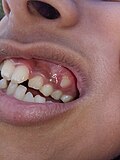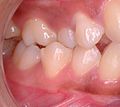Malocclusion: Difference between revisions
From WikiMD's Wellness Encyclopedia
CSV import |
CSV import Tags: mobile edit mobile web edit |
||
| Line 29: | Line 29: | ||
{{stub}} | {{stub}} | ||
<gallery> | |||
File:Dental_problem_in_10-year-old_girl_-_1.jpg|Malocclusion | |||
File:Class1type2.jpg|Class I Type 2 Malocclusion | |||
File:Class_II.jpg|Class II Malocclusion | |||
File:Treat_open_bite.jpg|Treatment of Open Bite | |||
</gallery> | |||
Revision as of 05:02, 18 February 2025
Malocclusion refers to the misalignment or incorrect relation between the teeth of the two dental arches when they approach each other as the jaws close. The term was coined by Edward Angle, the "father of modern orthodontics," as a derivative of occlusion, which refers to the way opposing teeth meet (occlude). Malocclusion is a common dental condition.
Types of Malocclusion
There are three major types of malocclusion, classified by Edward Angle:
- Class I: The molar relationship of the occlusion is normal or as described for the maxillary first molar, but the other teeth have problems like spacing, crowding, over or under eruption, etc.
- Class II: In this situation, the molar relationships shows the buccal groove of the mandibular first molar is distally positioned when in occlusion with the mesiobuccal cusp of the maxillary first molar. Usually the mesiobuccal cusp rests in between the mandibular first molar and second premolar. This is also known as distocclusion.
- Class III: In this situation, the buccal groove of the mandibular first molar is mesially positioned to the mesiobuccal cusp of the maxillary first molar. This is also known as mesioclusion or prognathism.
Causes
Malocclusion can be a result of several factors, including:
- Genetics: Malocclusion often runs in families, suggesting a genetic basis for some types.
- Habits: Certain habits may lead to malocclusion, such as thumb sucking, tongue thrusting, prolonged use of a bottle, and use of a pacifier.
- Injury: An injury that results in misalignment of the jaw can cause malocclusion.
- Tumors: Tumors in the mouth or jaw can also cause malocclusion.
Treatment
Treatment for malocclusion generally involves orthodontic therapy. The most common treatment is the use of braces. Other treatments may include removal of teeth, surgery to reshape or shorten the jaw, or wires or plates to stabilize the jaw bone.





